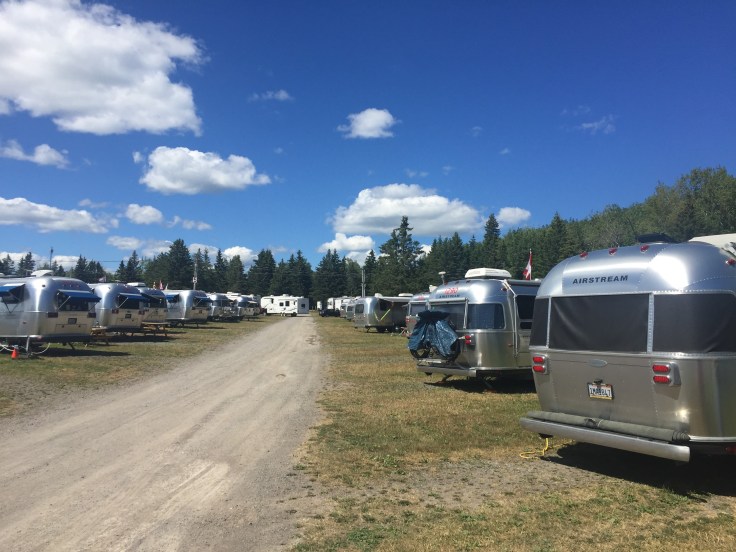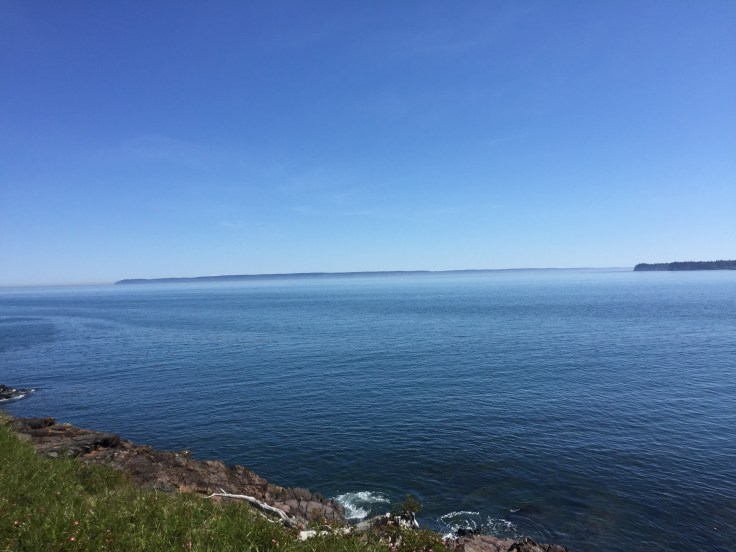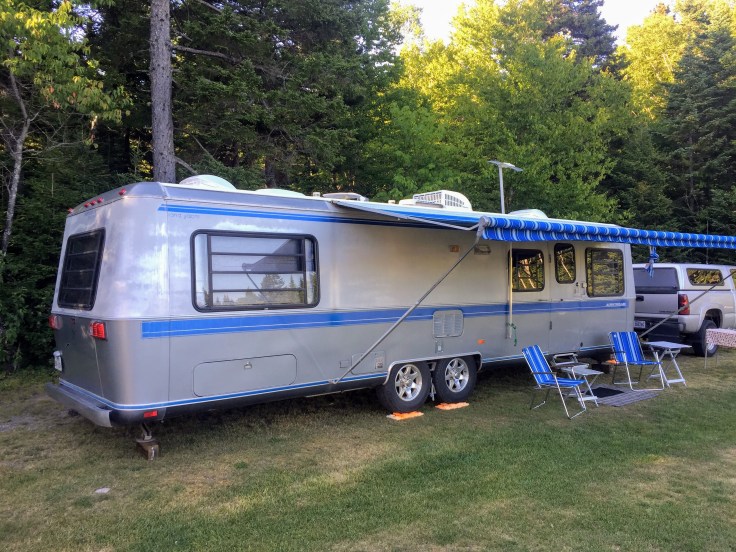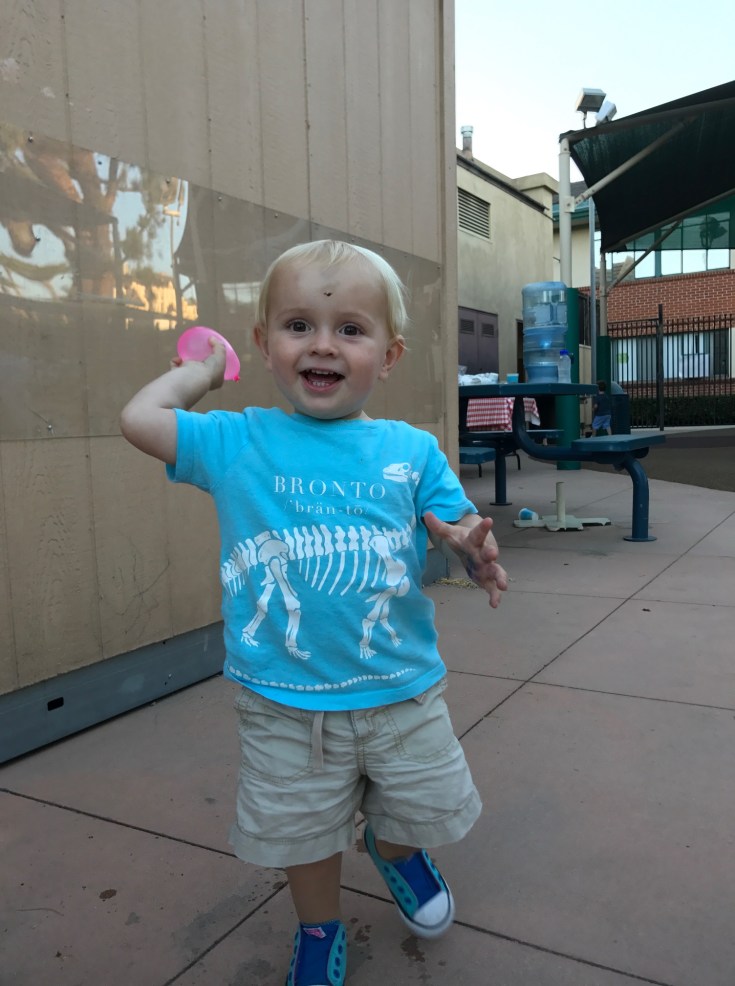We began our day in the rain. It was very overcast and foggy. We drove to the lighthouse:
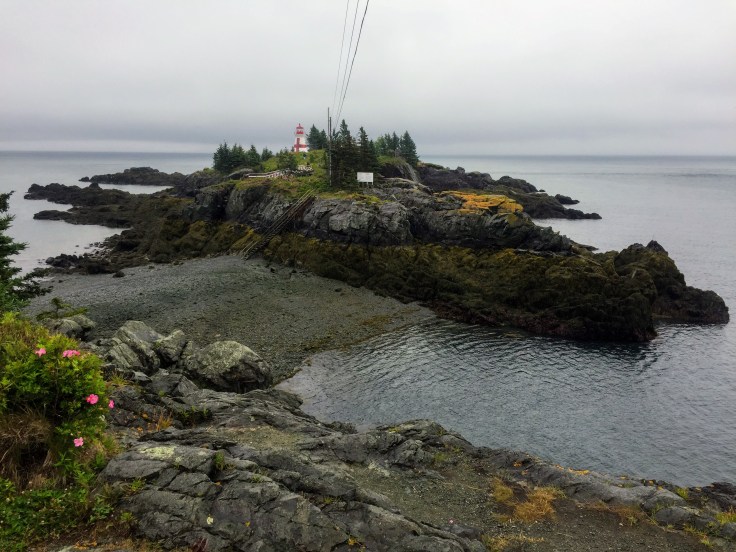
The lighthouse is on the northernmost tip of the island, and it is only accessible at low tide; at high tide it becomes its own island. Tides here are about 18′-20′, this being within the Bay of Fundy. (More on that in a few days…)
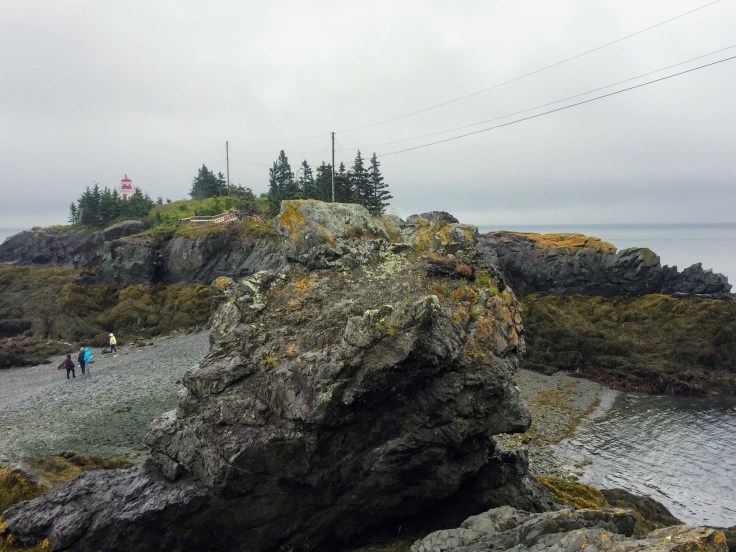
First you have to climb down steep steps to the “beach”, which, at high tide, is the ocean floor…) Then you have to walk across the rocks and seaweed and climb up steep steps on the opposite side to access the lighthouse.
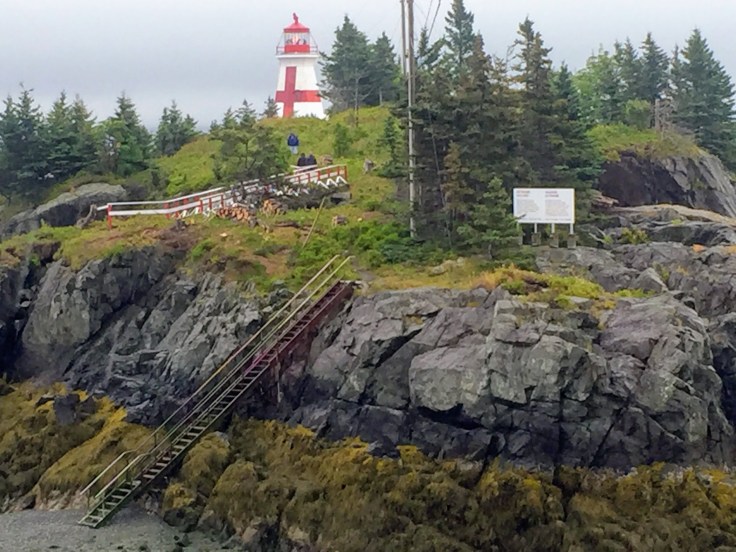
We’ve seen lighthouses before, and several people had already slipped and fallen by the time we arrived, so we stayed on the safe upper path…
After enjoying the view of the lighthouse we drove through the rest of the northern part of the island. This area is very sparsely populated, and the scenery was beautiful.

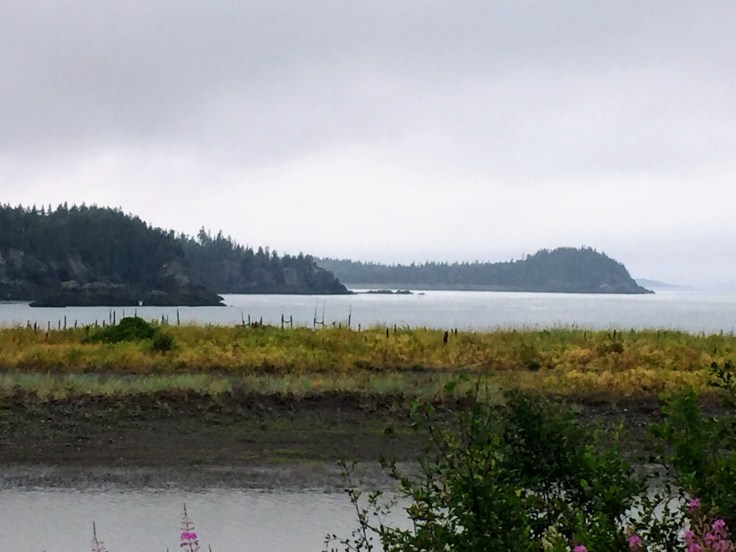
These small “islands” are actually salmon farms:

We then headed to the main attraction of the day: Franklin and Eleanor Roosevelt’s “cottage” here on the island…

Franklin Roosevelt spent many enjoyable vacations at his summer home on Campobello Island in New Brunswick’s Bay of Fundy.
FDR’s “cottage” has been preserved, and is almost exactly as it was in 1920, the summer before Franklin was stricken with polio. We were able to tour the first and second floors of the 34-room memorabilia filled cottage. Guides were stationed throughout the home to offer interpretation and answer questions about the house, its historic furnishings, and the family. Interestingly, a ramp installed a few years ago provides easy access to the first floor, although FDR never added a ramp to accommodate his wheelchair… (But, then again, he had “people”…)
The “cottage” was built in 1897 for Mrs. Hartman Kuhn, of Boston. It is next door to the cottage of FDR’s parents, where he summered as a child. Mrs. Kuhn developed a fondness for Eleanor when Franklin and Eleanor summered at his mother’s cottage next door. A provision in Mrs. Kuhn’s will offered her cottage to FDR’s mother, Sara, for $5,000.00. Sara purchased the furnished cottage and 5 acres of land in 1909, and gave the cottage to Franklin and Eleanor. The growing family spent summers in the cottage from 1909 to 1921. FDR altered the design of the house in 1915, when he added a new wing to provide additional space for his growing family.
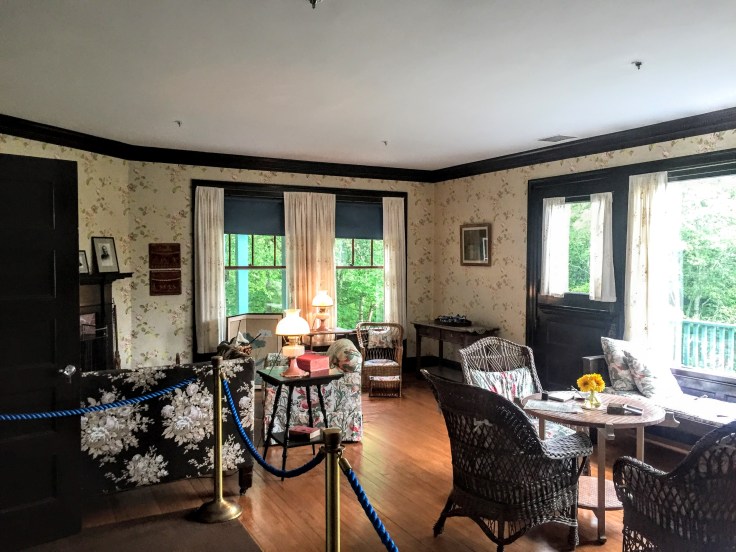

FDR’s cottage exhibits design principles of the Arts and Crafts movement, and also elements of early Dutch-American Colonial architecture. Considerations in the design of summer homes of the era were comfort, orientation to a scenic view and to the sun, and a “picturesque charm” so valued by the Arts and Crafts Movement.
I’m told that the cottage contains 34 rooms, 18 of which are bedrooms and 6 of which are bathrooms, although I didn’t count them. The third floor, which we didn’t see, contained guest rooms and servants’ rooms, and, I assume, 3 bathrooms… There was even a bedroom on the second floor for Louis Howe, FDR’s political adviser…
The Kitchen:

The Servants Dining, in the Kitchen:

The Laundry:

The Master Bedroom:

The cottage was considered quite modern for its time, but had neither electricity nor telephone. Kerosene lamps and candles provided light. Seven fireplaces and kitchen coal and wood-fired stoves provided heat. It even had hot and cold running water for bathing, cooking, and cleaning. (Many cottages on the island had neither kerosene lamps nor running water… these people prided themselves as being “rustic”, but they also had servants to feed the fireplaces, light the candles, cook the meals, haul the water, and empty the chamber pots…) The water came from storage tanks on the third floor of the cottage. The storage tanks were fed by gravity from a tank atop a nearby windmill. Drinking water came in large bottles by horse and cart, from a spring called Barrel Well.
Every summer, the Roosevelts brought a nurse and a governess to tutor and instruct the children, and several servants to run the cottage. Campobello residents were hired to help with the daily chores.
The rear of the house (note the screened porch):

The view from the house:

The rear of the house from the water’s edge, at the dock:

Lynda standing on the dock:

In addition to the Roosevelt cottage we were able to see the Hubbard Cottage… It sits adjacent to FDR’s cottage, on the other side of where FDR’s mother cottage was:

(They are working on replacing some siding; thus, the cherry-picker…)
Only the first floor was available to tour, but there were grand rooms to see:



And a grand porch:

The rear of the house:
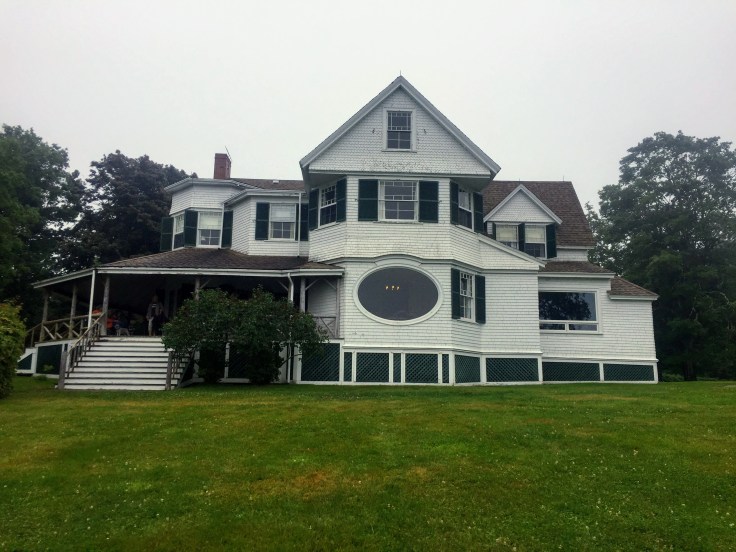
We spent the middle of the day at Josie’s porch, a local coffee-house and general community hang-out. But they had good internet access, so we spent some quality time catching up on important things…
Later that afternoon we had “Tea with Eleanor”. We assembled at the Wells-Shober house; we were led into parlors and dining room where the 49 of us sat and enjoyed tea and cookies. Two docents spoke for about 45 minutes on the life and times of Eleanor Roosevelt. She had a tough life growing up, losing her parents at an early age and attending boarding schools in England and other parts of Europe. It was interesting to hear all this; she never sought the limelight, and hated politics, but she did what she knew was right. After FDR was struck down by polio, it was she who went out and gave speeches to keep FDR in the public eye. After FDR’s death she continued to champion women’s rights and civil rights. During WWII she traveled the world, meeting military personnel in hospitals. She wrote personal letters to the families of everyone she met; sometimes she wrote 12-14 hours per day for months on end to give these families some sense of comfort.
She last returned to Campobello Island in 1962 for the dedication of the FDR bridge from Maine onto the island.
The Wells-Shober Cottage:

Waiting to be taken in:

Hilarity ensues as we try to find our places:

The docents, telling their stories: (The short one is a 10th generation islander…)

After the tea, the ladies of the caravan assembled for a group picture, as is the caravan’s tradition…

After tea we returned to the campground and readied ourselves for another travel day. We had a “Drivers’ Meeting” to discuss timing and routing. We met in the campground recreation room; apparently they’ve been having good times, based on this sign…
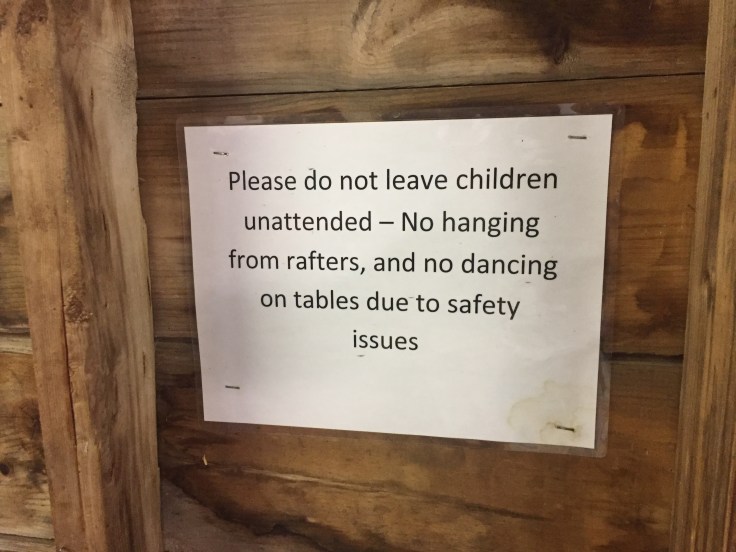
As always, an enjoyable time was had by all…


